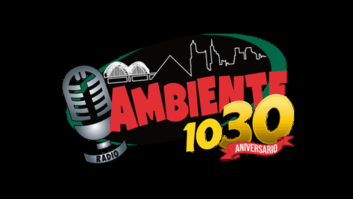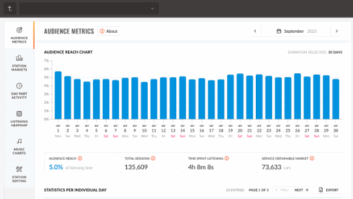Meanwhile, Manufacturers Also Explore Making Units Smaller, More Compact
The new breeds of IBOC transmitters on the floor at the NAB2004 convention in Las Vegas weren’t that big – and they’re anything but generic.
Implementation choices for FM IBOC range from low-level combining, to a new “mid” level, and high-level combining of the analog and digital signals. And now that the use of duel antennas has been approved by the FCC under certain criteria, engineers may choose to keep separate digital and analog air chains.
Harris, Broadcast Electronics and Nautel were the first equipment manufacturers companies to license the IBOC transmission technology from Ibiquity Digital Corp. They each had new IBOC HD Radio transmitters on display at NAB2004.
Harris used NAB2004 to roll out its Mini-HD FM series of HD Radio transmitters. The Mini-HD series includes configurations from 10 W to 600 W and supports multiplexer input, interleaved antenna and separate antenna designs, complementing the existing Z-HD product line.
Like the Z-HD transmitters, the Mini-HD line can be ordered with the Harris NeuStar option. NeuStar enables the transmitters to support 5.1 surround sound and supplemental audio channels.
Broadcast Electronics rolled out an updated version of its solid-state FM transmitter line. These analog units, in power levels that range up to 20 kW, are upgradeable to HD Radio as soon as they’re shipped from the factory, eliminating the need for PA module replacements or control system modifications.
BE showed its new XPi10 and Exgine FM HD Radio signal generator.
Another big name in transmitters has a new name this year: Continental Electronics is now DRS Broadcast Technology, although the Continental name remains the brand for its transmitters.
This year, the line includes the first of a series of solid-state FM transmitters, the 815D5 and, for HD Radio, the 815HD5. These 5 kW units use Continental’s “Pure Reliable Deployment” design, an RF combining and splitting system that the company says is tested to withstand up to three times its operating RF requirements, and can continue to deliver rated output power if multiple amplifier modules fail.
Continental continues to add to its shortwave transmitter line. This year’s version of the 418G 100kW shortwave transmitter includes a new control system and the ability to handle the Digital Radio Mondiale standard for digital broadcasting.
Nautel introduced the Jazz 1000, a 1,000-watt, 19-inch rackable AM transmitter; Maestro FM Exciter; and Virtuoso 10 kW FM Transmitter. All are designed for HD Radio transmission and integration with Nautel’s NE IBOC digital generator.
Nautel added to its solid-state line this year with its compact Virtuoso 10, a 10kW FM-HD Radio transmitter for low-level, high-level or space combining. The company also introduced the Maestro 50, a 50-watt direct-to-channel digital FM exciter, which ships ready to operate in analog, analog/HD Radio and all-digital modes.
Armstrong displayed its solid-state, HD Radio-ready AM transmitters, and solid-state and single-tube FM transmitters from 10 W to 30 kW.
Compact units
Another category that’s been increasingly visible on the floor at recent NAB exhibitions is that of ultra-small low-power AM and FM transmitter. This niche features new entries.
Old-time engineers accustomed to 1 kW rigs that filled several racks’ worth of space probably would find it hard to imagine today’s solid-state units, which take up just a few inches of rack space and can be hauled from site to site easily.
For today’s engineers, of course, such units have become useful tools for emergency backup, low-power post-sunset/pre-sunrise operation on AM or even as primary transmitters where space is tight.
Energy-Onix displayed entries in this category as well. Its Pulsar 250B, 500B and 1000B solid-state PDM AM transmitters consist of a two-piece basic chassis just 10.5-inches high, weighing 70 pounds and offering 70 percent overall efficiency.
Bext Inc. has debuted the XT 1000 frequency-agile 1 kW FM transmitter. In addition, the company showed its Star Point and Constant Impedance FM high-power combiner systems and a new FM band pass filter that can be used to build multichannel combiners.
Crown Broadcast IREC has its Signal Clear FM250G at the show, a 250 W FM transmitter that it says meets the strict requirements for low-power broadcasting in Europe.
Also on display was its Omnia DP3 three-band digital audio processor, available as an option on new and existing “T” series transmitters; and the RTC redundant transmitter controller, which enables two Crown transmitters to be connected for multiple (1+1 or 1+n) backup capability.
Continental Lensa introduced an IBOC-compatible AM solid-state digital transmitter with power levels from 1.5 kW to 100 kW.
RIZ Transmitters Co. brought its RIZ DRM Compact Solution from Croatia; it is a DRM-ready exciter that works with older analog transmitters in the shortwave, long wave and AM bands.
RVR Elettronica showed the TEX-1000LCD FM exciter/amplifier, which offers adjustable output up to 1 kW, multivoltage power supply and an internal stereo generator in a compact body 3 RU high, with telemetry and remote control capability. RVR also showcased compact PJ1000M-C and PJ2000M-C 1 kW and 2 kW amplifiers for FM broadcasters.
And on the tube front, Eimac displayed its new 4CM100,000G-power tetrode, designed for shortwave and digital shortwave DRM transmitters.
This story originally appeared in the NAB Daily News and is (c)NAB.







